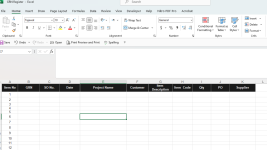Hi members.
I hope someone will help me out on this requirement of mine.
I have to excel files GRN (Good Received Note) and DN (Deliver Note) with columns headers named. I need a access database which when i open the file, it will open the form page with options like, Good Received Note and Delivery Note.
1- if I click GRN it will show below the fields for data entry for GRN
2- if i click DN it will open below the options for DN entry.
3- one button to generate reports as per any search field like GRN reports, DN reports, Supplier reports, products reports etc. the reports output view/table will be simple and same for any report.
4- GRN form (material enter to store) quantities and DN form ( material out from store) quantities always add ot subtract from total item quantities to know the available stock for each item.
5- any item is low on stock when you entering DN data must be shown by change of colour or by any easy way to bring it to the attention of the user.
I have sample access file for this purpose but it does not do few missing requirements like reports by search criteria or adding or subtracting the total item quantity.
Thank you all in advance for your support and valuable time for my request.
Attached:
1- GRN and DN files screenshot (xlsx extension files are not allowed to attach)
2- Access inventory sample file
I hope someone will help me out on this requirement of mine.
I have to excel files GRN (Good Received Note) and DN (Deliver Note) with columns headers named. I need a access database which when i open the file, it will open the form page with options like, Good Received Note and Delivery Note.
1- if I click GRN it will show below the fields for data entry for GRN
2- if i click DN it will open below the options for DN entry.
3- one button to generate reports as per any search field like GRN reports, DN reports, Supplier reports, products reports etc. the reports output view/table will be simple and same for any report.
4- GRN form (material enter to store) quantities and DN form ( material out from store) quantities always add ot subtract from total item quantities to know the available stock for each item.
5- any item is low on stock when you entering DN data must be shown by change of colour or by any easy way to bring it to the attention of the user.
I have sample access file for this purpose but it does not do few missing requirements like reports by search criteria or adding or subtracting the total item quantity.
Thank you all in advance for your support and valuable time for my request.
Attached:
1- GRN and DN files screenshot (xlsx extension files are not allowed to attach)
2- Access inventory sample file


